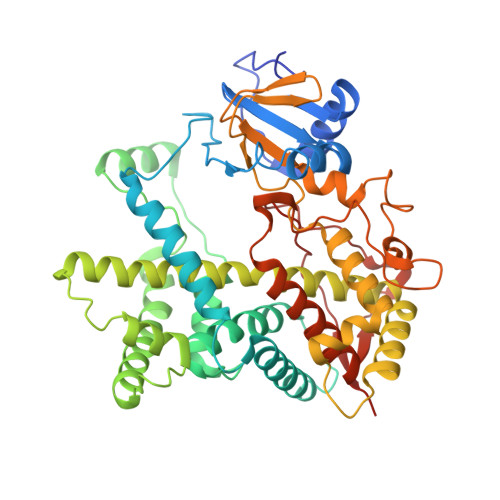Structure of microsomal cytochrome P450 2B4 complexed with the antifungal drug bifonazole: insight into P450 conformational plasticity and membrane interaction.
Zhao, Y., White, M.A., Muralidhara, B.K., Sun, L., Halpert, J.R., Stout, C.D.(2006) J Biol Chem 281: 5973-5981
- PubMed: 16373351
- DOI: https://doi.org/10.1074/jbc.M511464200
- Primary Citation of Related Structures:
2BDM - PubMed Abstract:
To better understand ligand-induced structural transitions in cytochrome P450 2B4, protein-ligand interactions were investigated using a bulky inhibitor. Bifonazole, a broad spectrum antifungal agent, inhibits monooxygenase activity and induces a type II binding spectrum in 2B4dH(H226Y), a modified enzyme previously crystallized in the presence of 4-(4-chlorophenyl)imidazole (CPI). Isothermal titration calorimetry and tryptophan fluorescence quenching indicate no significant burial of protein apolar surface nor altered accessibility of Trp-121 upon bifonazole binding, in contrast to recent results with CPI. A 2.3 A crystal structure of 2B4-bifonazole reveals a novel open conformation with ligand bound in the active site, which is significantly different from either the U-shaped cleft of ligand-free 2B4 or the small active site pocket of 2B4-CPI. The O-shaped active site cleft of 2B4-bifonazole is widely open in the middle but narrow at the top. A bifonazole molecule occupies the bottom of the active site cleft, where helix I is bent approximately 15 degrees to accommodate the bulky ligand. The structure also defines unanticipated interactions between helix C residues and bifonazole, suggesting an important role of helix C in azole recognition by mammalian P450s. Comparison of the ligand-free 2B4 structure, the 2B4-CPI structure, and the 2B4-bifonazole structure identifies structurally plastic regions that undergo correlated conformational changes in response to ligand binding. The most plastic regions are putative membrane-binding motifs involved in substrate access or substrate binding. The results allow us to model the membrane-associated state of P450 and provide insight into how lipophilic substrates access the buried active site.
Organizational Affiliation:
Department of Pharmacology and Toxicology, University of Texas Medical Branch, Galveston, TX 77555, USA. yozhao@utmb.edu

















